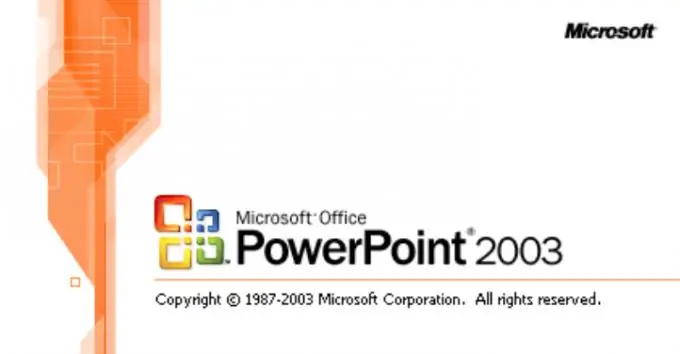Presentations are a universal tool for marketers and designers, educators and coaches, engineers, analysts and economists. Creation of presentations is practiced both for work purposes for visualizing a large amount of information, and for creating a bright and colorful video sequence of paintings, cliparts, photographs, collages and educational slides for children.

Instructions
Step 1
To create a presentation, it is best to use Microsoft Office PowerPoint 2003 or 2007. When you install office applications on any computer, PowerPoint is automatically included in the list of standard Microsoft Office programs. With the help of Microsoft Office PowerPoint you can create any presentation: simple and schematic, with graphs and diagrams, bright and dynamic, replete with photographs, flash elements and design delights. It all depends on the perseverance, imagination and professionalism of the creator of the presentation.
Step 2
To start the process of creating a presentation, you need to launch the program and select a slide layout. To do this, on the desktop, right-click on the free space where there are no files, and then from the menu that appears, select "create" and the desired program - "Microsoft PowerPoint presentation".
Step 3
You can add, delete and move presentation slides in the left column. To create, right-click anywhere and select "create slide". To delete, you need to click on the extra slide and select "delete" from the menu that appears. To move, you need to hold down the desired slide with the left mouse button, and then move it to a new place.
Step 4
For a new slide, the first step is to choose the layout, i.e. outline where the title, text material, pictures, graphics and other elements will be located. Microsoft PowerPoint already has presets with variations, so you can use them. Right-click on the created slide and select "slide layout" from the menu. Review all suggested options from the left column and choose the one that best suits your presentation. The layout can be selected both for the entire presentation as a whole, and for each slide separately.
Step 5
With the Design feature, you can choose a presentation design template, color scheme, or set specific animation effects. To work with this functionality, find a button with this name on the toolbar, usually it is located on the right. The program database contains the most popular general theme templates for presentation design.
If you want to apply a design template only to a specific slide or to several, then you need to hover the cursor over the desired design, left-click on the field with an arrow that appears on the side and select the option "apply to selected slides".
If you have the skills to work with graphic programs, you can create unique templates for presentations from your own drawings, photographs and cliparts. To add your own picture as a background, you need to select "insert" in the top menu, find "picture" in this tab and select the option "from file". Upload the picture you want. To prevent it from obscuring the text and other information, you need to right-click on it, select "order" and set it "to background."

Step 6
For clarity, it is recommended to provide individual slides with photographs, video materials, graphs and diagrams. Almost any graphic material can harmoniously fit into the overall style of the presentation, especially since the functionality allows you to sound the presentation and even provide slides with separate sound effects.
Step 7
For each slide with text information, you can select the font, size and color. If you are preparing a project for a large audience on the wall rather than on a computer, make the font larger. From the last rows, it will be difficult to make out a 12-15 point font. In some ways, working with the text part of a presentation is similar to the functionality of Microsoft Office Word. For clarity and better perception of information, add an empty line between paragraphs. Use lists, tables, graphs more often to make the text material more interesting.
Step 8
Video and audio materials will help liven up your presentation, but it is important to keep it in moderation. If you are going to tell something in parallel with the presentation, you do not need to insert background music. Better to add sound effects in places when important information appears or slides switch. To add such an effect, you need to select the "insert" tab in the top menu and in it "movies and sound". Find the file you want, add it and specify when to play it - on click or when loading a slide. Videos are added in the same way.

Step 9
Add animation when changing slides so that they smoothly transition into one another. To do this, right-click on the desired slide, select "change slides" from the menu that appears, and a column with transition options will appear on the left side. If you want, you can click the "apply to all slides" button, so as not to set up individual animation for each.
Step 10
When your presentation is complete, check that the slides are displayed correctly and the animation is playing. To do this, select the "view" tab in the top menu and "play slides" in it. Or just press the F5 button on your keyboard. All slides will be played in the specified sequence, replaced after a specified period of time or by clicking the mouse. If necessary, you can freely move between slides - right-click anywhere, select "next", "back", "go to slide" and select the desired one. So you can quickly get to the right place, which is important in a long presentation.






